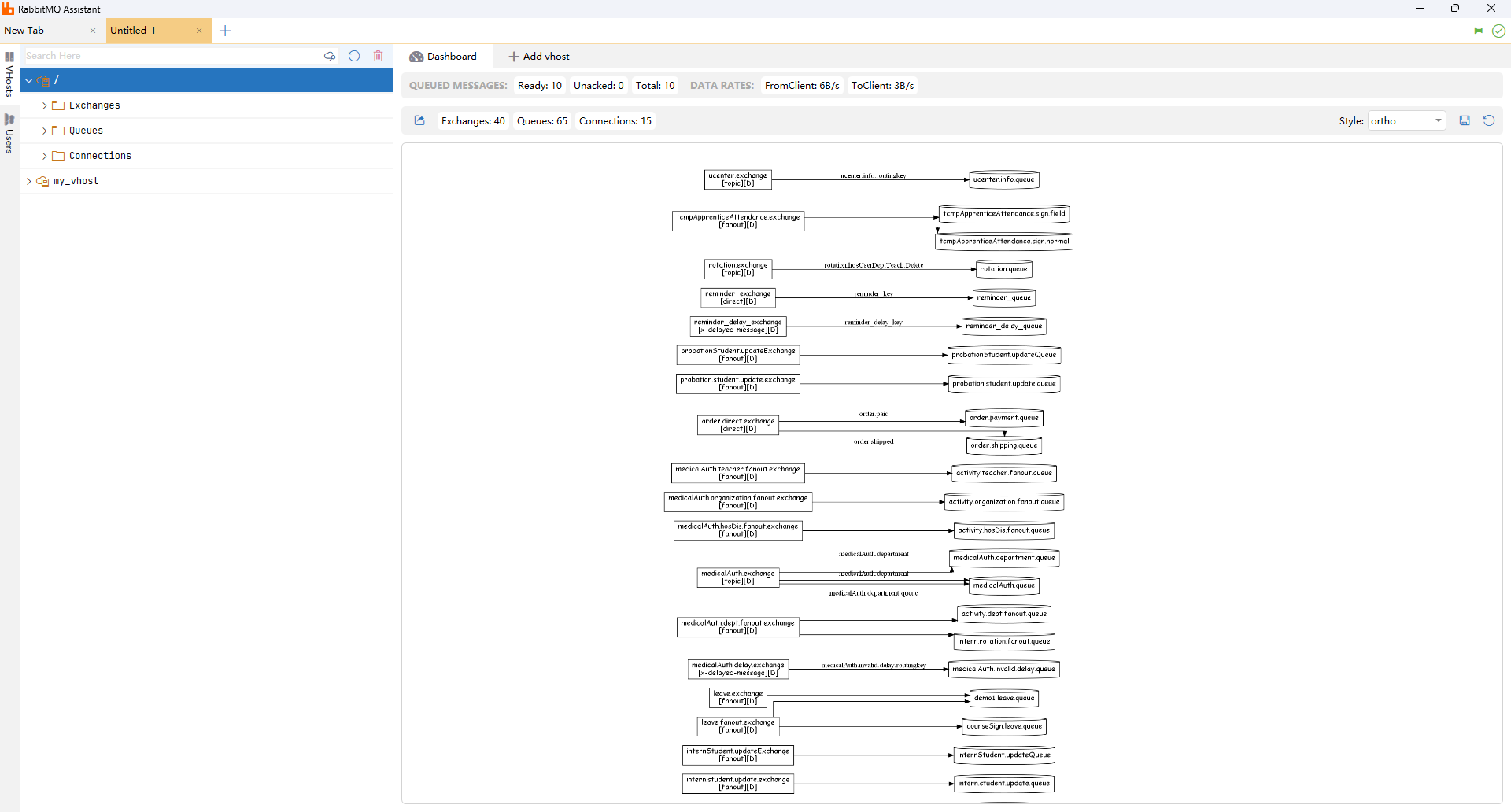RabbitMQ Assistant是RabbitMQ可视化管理与监控工具
# 主要功能
主要功能包括:
- GPU渲染:RabbitMQ Assistant 在渲染界面时充分利用您的 GPU。这带来流畅的的用户体验,同时使用比以前更少的功率。
- 生成拓扑图:为指定的vhost一键生成拓扑图,支持导出png、svg、pdf、tk等多种格式,让您的消息流动一目了然。
- 测试生产者和消费者:您可以测试解决方案的各个部分,模拟进出的第三方消息。您可以创建和编辑测试消息,一个接一个或批量发送。
- 数据格式化:RabbitMQ Assistant 会自动识别并格式化不同的消息格式,包括Text、JSON、XML、HEX、MessagePack,以及各种整数、浮点类型。
- 查看系统状态:您可以一目了然地查看系统状态,检查某些队列是否变得太大,死信队列中是否有消息等。通过自动刷新功能,可以近乎实时地查看整个系统的工作方式。
- 创建消息:创建消息时,可以指定消息头、属性和载荷;或者一次发送数千条消息进行性能测试,以了解系统如何处理负载。
# 连接远程MQ
由于 RabbitMQ Assistant 仅在连接本地时提供免费服务,而连接远程地址则需收费,因此使用 Nginx 将本地端口反向代理到远程地址。
# 1、下载 Nginx
访问 Nginx 官方网站 (opens new window) 或 Nginx 中文网,选择适合的版本并下载。将下载的压缩包解压到目标目录(如 D:\Tools\Nginx)。 注意: 路径中不要包含中文字符或空格。
# 2、启动 Nginx
打开命令提示符,进入 Nginx 解压目录:
cd D:\Tools\Nginx
start nginx
1
2
2
如果防火墙弹出提示,请允许访问网络。
在浏览器中访问 http://localhost,若显示欢迎页面,则启动成功。
# 3、修改配置文件
配置文件位于 conf/nginx.conf。打开该文件,找到 server 节点,根据需要修改或添加配置。例如:
反向代理示例:
server {
listen 80;
server_name example.com;
location / {
proxy_pass http://127.0.0.1:8080;
}
}
1
2
3
4
5
6
7
2
3
4
5
6
7
负载均衡示例:
upstream backend {
server 127.0.0.1:8080;
server 127.0.0.1:8081;
}
server {
listen 80;
server_name example.com;
location / {
proxy_pass http://backend;
}
}
1
2
3
4
5
6
7
8
9
10
11
12
2
3
4
5
6
7
8
9
10
11
12
我们的需求只需要反向代理,因此增加server代理本地端口5557到远程http://192.168.100.105:15672
nginx.conf如下
#user nobody;
worker_processes 1;
#error_log logs/error.log;
#error_log logs/error.log notice;
#error_log logs/error.log info;
#pid logs/nginx.pid;
events {
worker_connections 1024;
}
http {
include mime.types;
default_type application/octet-stream;
#log_format main '$remote_addr - $remote_user [$time_local] "$request" '
# '$status $body_bytes_sent "$http_referer" '
# '"$http_user_agent" "$http_x_forwarded_for"';
#access_log logs/access.log main;
sendfile on;
#tcp_nopush on;
#keepalive_timeout 0;
keepalive_timeout 65;
#gzip on;
#server {
# listen 80;
# server_name localhost;
#
# #charset koi8-r;
#
# #access_log logs/host.access.log main;
#
# location / {
# root html;
# index index.html index.htm;
# }
#
# #error_page 404 /404.html;
#
# # redirect server error pages to the static page /50x.html
# #
# error_page 500 502 503 504 /50x.html;
# location = /50x.html {
# root html;
# }
#
# # proxy the PHP scripts to Apache listening on 127.0.0.1:80
# #
# #location ~ \.php$ {
# # proxy_pass http://127.0.0.1;
# #}
#
# # pass the PHP scripts to FastCGI server listening on 127.0.0.1:9000
# #
# #location ~ \.php$ {
# # root html;
# # fastcgi_pass 127.0.0.1:9000;
# # fastcgi_index index.php;
# # fastcgi_param SCRIPT_FILENAME /scripts$fastcgi_script_name;
# # include fastcgi_params;
# #}
#
# # deny access to .htaccess files, if Apache's document root
# # concurs with nginx's one
# #
# #location ~ /\.ht {
# # deny all;
# #}
#}
# another virtual host using mix of IP-, name-, and port-based configuration
#
#server {
# listen 8000;
# listen somename:8080;
# server_name somename alias another.alias;
# location / {
# root html;
# index index.html index.htm;
# }
#}
# HTTPS server
#
#server {
# listen 443 ssl;
# server_name localhost;
# ssl_certificate cert.pem;
# ssl_certificate_key cert.key;
# ssl_session_cache shared:SSL:1m;
# ssl_session_timeout 5m;
# ssl_ciphers HIGH:!aNULL:!MD5;
# ssl_prefer_server_ciphers on;
# location / {
# root html;
# index index.html index.htm;
# }
#}
server {
listen 5557;
server_name localhost;
location / {
proxy_pass http://192.168.100.105:15672;
proxy_set_header Host $host;
proxy_set_header X-Real-IP $remote_addr;
proxy_set_header X-Forwarded-For $proxy_add_x_forwarded_for;
proxy_set_header X-Forwarded-Proto $scheme;
proxy_redirect off;
proxy_buffering off;
proxy_request_buffering off;
proxy_http_version 1.1;
proxy_set_header Connection "";
}
}
}
1
2
3
4
5
6
7
8
9
10
11
12
13
14
15
16
17
18
19
20
21
22
23
24
25
26
27
28
29
30
31
32
33
34
35
36
37
38
39
40
41
42
43
44
45
46
47
48
49
50
51
52
53
54
55
56
57
58
59
60
61
62
63
64
65
66
67
68
69
70
71
72
73
74
75
76
77
78
79
80
81
82
83
84
85
86
87
88
89
90
91
92
93
94
95
96
97
98
99
100
101
102
103
104
105
106
107
108
109
110
111
112
113
114
115
116
117
118
119
120
121
122
123
124
125
126
127
128
129
130
131
132
133
134
2
3
4
5
6
7
8
9
10
11
12
13
14
15
16
17
18
19
20
21
22
23
24
25
26
27
28
29
30
31
32
33
34
35
36
37
38
39
40
41
42
43
44
45
46
47
48
49
50
51
52
53
54
55
56
57
58
59
60
61
62
63
64
65
66
67
68
69
70
71
72
73
74
75
76
77
78
79
80
81
82
83
84
85
86
87
88
89
90
91
92
93
94
95
96
97
98
99
100
101
102
103
104
105
106
107
108
109
110
111
112
113
114
115
116
117
118
119
120
121
122
123
124
125
126
127
128
129
130
131
132
133
134
# 4、重载配置
修改完成后,运行以下命令重载配置:
nginx -s reload
1
常用命令
- 查看版本:nginx -v
- 停止服务:nginx -s stop
- 优雅停止:nginx -s quit
- 重启服务:nginx -s reload
# 5、查看效果
浏览器访问地址localhost:5557会直接访问到远程mq地址

使用RabbitMQ Assistant连接


